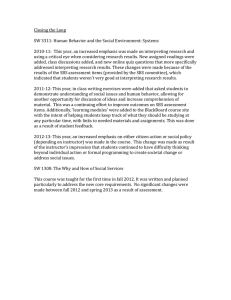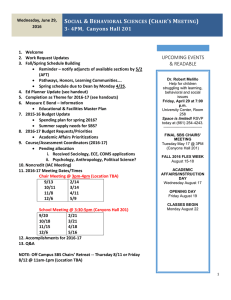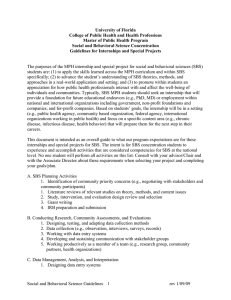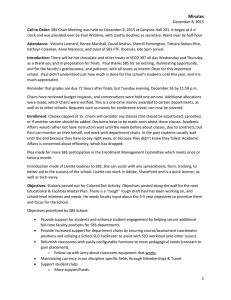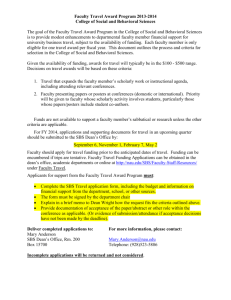9MB - Cudos
advertisement
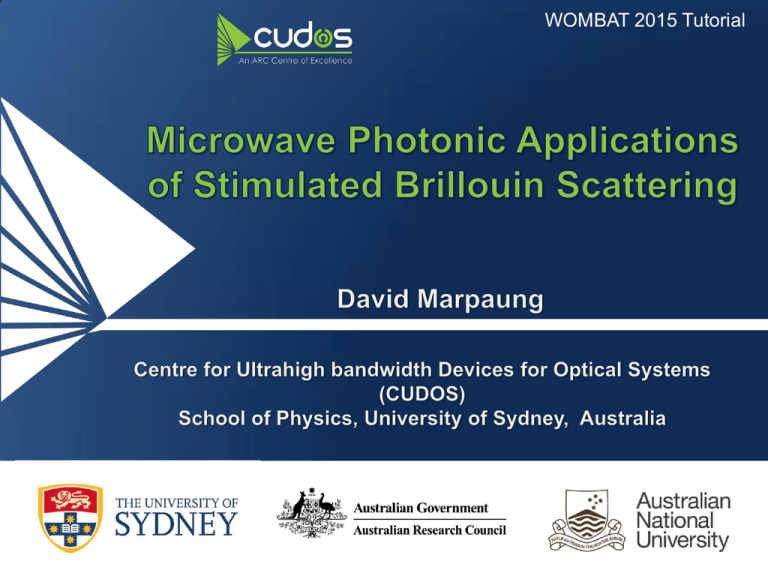
WOMBAT 2015 Tutorial Stimulated Brillouin scattering Applications: • Fiber sensing • Narrow linewidth laser • Slow light/ delay line • RF and optical filtering • Microwave oscillator • Microwave signal processing Eggleton et al,. Adv. Opt. Photon 5 (2013) Cavity optomechanics Microwave photonic applications of Brillouin scattering Applications: et al,. Sensors 11 (2011) • Bao Quantum optical measurement • Displacement sensing • Tunable optical filter • Slow light/ delay line • Optomechanical oscillator Metcalfe, App. Phys. Rev 1 (2014) Aspelmeyer et al., Rev. Mod Phys. 86 (2014) Fundamentals of Microwave Photonics Stimulated Brillouin Scattering Applications: • Bandpass and bandstop filters • Tunable delay lines and phase shifters • Low noise microwave oscillators Future of SBS microwave photonics Microwave photonics Microwave photonics (MWP): manipulation of RF signals using photonic techniques/components Capmany and Novak, Nat. Photon 1 (2007) Yao, J. Lightwave Technol. 27 (2009) Seeds and Williams, J. Lightwave Technol.24 (2006) Marpaung et al., Laser Photon. Rev. 7 (2013) vs. • Heavy (copper, 567 kg/km) • High loss(190 dB/km @ 6 GHz) • Rigid and large cross section • Lightweight • Low loss(0.25 dB/km) • Very flexible • • • • Radio over fiber Antenna remoting Ultra-wideband (UWB) Low phase noise synthesizer • • Filtering Phase shifter, tunable delay • • Spectrum analyzer IFM receiver E/O conversion O/E conversion f=0 f =p f=0 LS Optical frequency Optical frequency Optical frequency Intensity modulation (IM) Phase modulation (PM) Single sideband (SSB) modulation f=0 f =Df Challenges E/O and O/E conversion losses Optical frequency Complex modulation Laser phase and intensity noise (RIN) Nonlinear distortion Photodetector shot and thermal noise E/O conversion O/E conversion Figures of merit Link “gain” RF to RF loss (typical:-30 dB, good: ~ 0 dB ) Noise figure SNR in/SNR out (typical: 30 dB, good: <10 dB) Dynamic range margin of noise and distortion (typical: 80-90 dB, good >110 dB) Functionalities • filtering • delay • frequency conversion… Application Spectrally crowded environments • Wireless communications (5G) • Radar and EW Functionalities • filtering • delay • frequency conversion… Application Interference mitigation and filtering Interferer Frequency agile Tunable MWP interferer filter Power Spectrally crowded environments • Wireless communications (5G) • Radar and EW Solution Signal Radio frequency Functionalities • filtering • delay • frequency conversion… Application Satellite communications • On-board wifi and live television Phased array antenna Solution Tunable true time delay AWG (Purdue) Silicon modulator, WGs Optical beamformer (U.Twente & LioniX) Si3N4 Passive WGs, thermal tuners Discriminator filters (UPV) InP WGs, thermal tune, BPD OEO (OEWaves) LiNbO3 WGMR, electronics Marpaung et al, Laser Photonics Rev. 7, No. 4, 506–538 (2013) Stimulated Brillouin Scattering Stimulated Brillouin Scattering (SBS) • One of the strongest nonlinear optical effects • Results from a coherent interaction between vibrations and electromagnetic waves The fundamental physical effects of the interaction are: Electrostriction: Electric field causes material compression [Light influences sound] The photo-elastic effect: Compressive strain causes change in refractive index [Sound influences light] Robert W. Boyd, “Nonlinear Optics”, San Diego, CA: Academic press 2001. 14 Stimulated Brillouin Scattering (SBS) The main effect of SBS is to resonantly excite an acoustic grating, which back-reflects the pump at exactly the acoustic frequency W. Intensity compresses material (electrostriction) Pump 1 w1 Doppler effect: Pump reflected, down-shifted to w2 Compression Excites creates acousticindex wavegrating (photoelasticity) frequency W waveguide Pump 2 w2w=2=w w1 1- W Robert W. Boyd, “Nonlinear Optics”, San Diego, CA: Academic press 2001. Eggleton et al,. Adv. Opt. Photon 5 (2013) 11/12/12 15 W W GB Fast light Gain (Stokes) Slow light wp w Loss (anti-Stokes) • SBS leads to a narrow Stokes peak in the counter-propagating direction • The Brillouin shift W is determined by the acoustic wave frequency • The linewidth is determined by the acoustic lifetime (~ 9 ns for silica) Typical values (Silica) W ~ 7-11 GHz GB ~ 15-50 MHz • Kramers-Kroenig relation: gain resonance refractive index change sharp amplitude and phase (delay) responses 11/12/12 16 First theoretical predictions1,2 First demonstration of SBS3 SBS in liquids4 On-chip SBS10 SBS in silicon12 SBS in gases5 Invention of the laser 1920 1. 2. 3. 4. 5. 6. 7. 8. 9. 10. 11. 12. 1960 Brillouin, Annals of Physics 17, 88, (1922) Mandelstahm, Rus. J. Phys. Chem (1926) Chiao et al. Phys. Rev. Letters 12, 592 (1964). Brewer et al. Phys. Rev. Letters 13, 334 (1964). Hagenlocker et al. Appl. Phys. Letters 7, 236 (1965) Ippen et al. Appl. Phys. Lett. 21, 539 (1972) Hill et al., App. Phys. Lett, 28 (1976) Dainese et al. Nature Physics 2, 388 (2006) Grudinin et al. Phys. Rev. Lett. 102, (2009) Pant et al. Opt. Exp. 19, 8285 (2011) SBS Lee et al. Nat. Photon. 6, 369 (2012) Shin et al. Nature Comm. 4, (2013). in optical fibres6 1970 First Brillouin laser7 1980 2000 SBS in PCF8 2010 Year of discovery SBS in WGM SBS in wedge resonators9 resonators11 SBS on chip-scale devices High-Q resonators Eggleton et al,. Adv. Opt. Photon 5 (2013) Waveguides with large Brillouin gain On-chip SBS is challenging because the waveguides are very short. The gain is g0 = Brillouin gain coefficient Pp = Pump power Leff = Waveguide length Aeff = optical mode area How to get enough gain in a chip scale device? 1) Material with high refractive index cladding 2) Small mode area 3) Low loss optical waveguides 4) Good opto-acoustic overlap Guiding/confinement of acoustic mode Determined by acoustic velocity in materials Pant et al., Opt. Express 19 (2011) Poulton et al. JOSA B 30 (2013) y x z Core Chalcogenide waveguide: 7 cm • High index material As2S3 (n~2.45, g0~n8) • Small mode area (Aeff ~ 2.3 µm2) • Low propagation loss (~0.2 dB/cm) • Large overlap of acoustic and optical modes Eggleton et al., Nature Photonics, (2011) vIPG ~ 1500 m/s vchalc ~ 2600 m/s vsilica ~ 6000 m/s Key parameters: • g0 ~0.74*10-9 m/W (~100 x silica) • W ~ 7.7 GHz • GB ~ 34 MHz • 16 dB gain for 300 mW pump Pant et al., Opt. Express 19 (2011) • Silicon has high refractive index • But no acoustic confinement in Si core • Phonon lifetime is very short for small waveguides SOI waveguide (n =3.48) Si (n =1.45) SiO2 (va ~ 8000 m/s) (va ~ 6000 m/s) Poulton et al. JOSA B 30 (2013) Phonon leakage • Si3N4 membrane for acoustic confinement • Forward SBS • Low gain ( <1 dB) • Breakthrough in SBS on chip • Under etched silicon • Forward SBS with ~4 dB of gain Shin et al, Nature Communications. 4 (2013) Application: filtering Loss RF out Power Gain On chip SBS bandpass filter RF Frequency Probe Pump SBS medium Phase modulator RF in • • • 2-12 GHz tuning 20 dB extinction SBS gain 20-40 MHz tunable bandwidth Df = ±p f=0 Byrnes et al., Opt. Express 20,frequency (2012) Optical > 50 dB extinction 6 MHz 3-dB width 11/12/12 Pagani and Shania., (unpublished) Zhang et al., IEEE Photon. Tech. Lett. 23 (2011) 22 • • • Broad reconfigurable bandwidth (tens of MHz-to GHz) Flat passband Sharp and high extinction • Stern et al., Photon. Res. 2 (2014) 11/12/12 Polarization pulling to enhance filter suppression • Pump sweeping for broad SBS • Result : 44 dB selectivity, 250 MHz -1 GHz tunable bandwidth • 3 dB passband flatness 23 • Electrical comb for SBS pump • Digital feedback for shape control • Non-uniform pump spacing to mitigate FWM improve flatness • Dual fiber stage to limit SRS and FWM improve selectivity • 50 MHz to 4 GHz tunable bandwidth • > 40 dB suppression up to 2 GHz width • ~ 1 dB passband flatness • Improve SNR Wei et al., Opt. Express 22 (2014) Wei11/12/12 et al., IEEE Photon. Tech. Lett.. 27 (2015) 24 Loss RF out Notch Power Gain RF Frequency Probe SSB modulator Pump SBS medium RF in SBS loss (anti-Stokes) Optical frequency • 2-8 GHz tuning • 20 dB extinction • 120 MHz 3-dB width (FWHM) • High pump power (350 mW) Morrison et al., Opt. Comm. 313 (2014) 11/12/12 25 Notch attenuation 3-dB Bandwidth Desired properties • High peak attenuation (>50 dB) • High resolution (FWHM ~ 10 MHz) • Large frequency tuning (tens GHz) • Bandwidth reconfigurability State-of-the-art RF filter RF Frequency IMWP filter • • • • SOI ring Rejection 30 dB FWHM 910 MHz Tuning 12 GHz M. Rasras, J. Lightwave Technol. (2009) • Attenuation >50 dB • Bandwidth ~ 10 MHz • Tuning: 3-4 GHz B. Kim, IEEE Trans. Elect. Dev. (2013) Input RF signal Output RF signal Power Power Novel MWP filter RF frequency Notch RF Frequency Laser f=0 LS EO modulator f =Df Df = ±p LS US Optical frequency Amplitude matching SBS gain filter Photodetector f=0 US Optical frequency Phase cancellation Phase and amplitude control Filter response Phase and amplitude filter Conventional Conventional SSB SSB G G= =1 1 dB dB Rejection: Rejection: 1 1 dB dB Novel filter G = 0.8 dB Rejection: 55 dB Pump = 8 mW D. Marpaung et al, Postdeadline paper Frontiers in Optics 2013 FW6B Conventional SSB G = 20 dB Rejection: 20 dB Pump = 350 mW 2900% fractional tuning Q= 375 at 30 GHz D. Marpaung et al., Optica, 2, 76-83 (2015) Conventional filter D. Marpaung et al., Optica, 2, 76-83 (2015) Cancellation filter Application: delay and phase shift Extreme broadening: 25 GHz bandwidth slow light Ultra-long delay: High gain SBS 10.9 ps delay Song et al., Opt. Lett. 32 (2007) On chip SBS slow light Song et al., Opt. Lett. 30 (2005) Analog applications 230 ps delay 1 GHz bandwidth Pant et al., Opt. Lett. 37 (2012) Zadok et al., IEEE Photon. Tech Lett. 19 (2007) Problem: require tunable large delays (~ns), large bandwidths • Applications (~GHz), high carrier frequency (microwave, mm-wave) it is difficult to achieve a (1) tunable, (2) large slope (3) wide band • But… linear phase response (w) Real phase response “True-time-delay” bandwidth Ideal phase response Actual phase Desired phase wc Burla et al., Opt. Express 19(22) (2011) wc wc w w ww w c c RFRF c RFw w • • • 100 MHz delay bandwidth 0.03 ns to 9.9 ns tunable delay 300o carrier phase tuning Chin et al., Opt. Express 18 (2010) Carrier Sideband 𝜔𝑐 − 𝜔𝑅𝐹 SBS pump spectrum: Ω𝐵 𝜔 𝜔𝑐 Ω𝐵 RF frequency cancelrange (360o) •Amplitudes Full tuning 𝜔 𝑝1 • 3 dB 𝜔 amplitude fluctuations • Bandwidth limited to 2WB Phase 𝜔𝑝2 RF frequency response Magnitude Optical signal spectrum: SBS phase shift: Loayssa Lahoz, Phases&add upIEEE Photon. Tech Lett. 18 (2006) 𝜔 RF frequency • • • Two degrees of freedom: amplitude and phase Ultra-wideband operation: 1 – 31 GHz Record-low amplitude fluctuations (< 0.5 dB) Pagani, et al., Opt. Lett., 39 (2014) Application: signal generation • • • • Silica on silicon wedge resonator Q = 875 million FSR matched to SBS shift Narrow linewdith SBS laser H. Lee, et al., Nat. Photon, 6 (2012) • • • 1st and 3rd Stokes beating to generate microwave frequency (~ 21 GHz) Electronic frequency division to achieve lower frequencies Low phase noise, comparable to commercial RF synthesizers J. Li, et al., Nat. Commun. (2013) Future direction Computer-controlled smart RF filter with high performance 1-30 GHz continuous frequency tuning tuning Tunable notch extinction Tunable filter resolution Tunable bandpass Marpaung et al., “Nonlinear integrated microwave photonics”, Journal of Lightwave Technol. 32 (invited, 2014) • AOM operating at 10 GHz • Reconfigurable filtering (?) • Link and interaction with SBS • • Potential for wider comb (?) Miniaturizing high quality light and RF source Microwave photonics • Manipulation of RF signals using photonic techniques • Promise: reduced footprint and weight, wide bandwidth • Challenge: conversion losses, noise, distortion SBS applications in MWP • Tunable filtering with performance unmatched by any technology • RF phase shifter with record-low amplitude fluctuation • RF synthesizer with low phase noise What the future holds: • High SBS gain in CMOS compatible chip • Functional SBS circuit (modulator, detectors, SBS engine) • Chip scale optical and RF sources Alvaro Casas-Bedoya, Amol Choudhary, Irina Kabakova, David Marpaung, Birgit Stiller, and Benjamin J. Eggleton University of Sydney Duk-Yong Choi, Steve J. Madden, Barry Luther-Davies Australian National University Christopher G. Poulton, Christian Wolff University of Technology Sydney (UTS) Main contributors Mattia Pagani Blair Morrison Shayan Shania Hengyun Jiang Iman Aryanfar Thank you
